World Football League (1974-1975)
Tombstone
Born: 1973 – WFL founding franchise
Folded: October 22, 1975
First Game: July 10, 1974 (L 8-7 @ Florida Blazers)
Last Game: October 19, 1975 (L 26-7 vs. Southern California Sun)
World Bowl Championships: None
Stadia
1974-1975: Honolulu Stadium (23,000)11975 Hawaiians Media Guide
Opened: 1926
Demolished: 1976
1975: Aloha Stadium (50,000)21975 Hawaiians Media Guide
Opened: 1975
Closed: 2020
Marketing
Team Colors: Brown, Gold & Scarlet31975 Hawaiians Program
Radio:
- 1975: KGMB (590 AM)
Radio Broadcasters:
- 1975: Joe Moore (play-by-play) & Dick Thornton (color)
Ownership
Owners:
- 1974: Chris Hemmeter & Sam Battistone
- 1975: Edward Sultan Jr., et al.
FWIL FAVORITE
the Hawaiians WFL
Logo T-Shirt
World Football League officials spoke grandly of future franchises in London, Mexico City, Osaka and Tokyo at the league’s launch in late 1973. As it turned out none of those international ambitions came to pass and Honolulu emerged as the upstart league’s most ambitious geographic flex.
This stylish Hawaiians tee design is available today from now from Royal Retros.
Background
The Hawaiians pro football team was the first North American major pro sports franchise based outside the continental United States and Canada. The team was part of the rebel World Football League (1974-1975), formed to challenge the NFL in the mid-1970’s.
Thanks to solid ownership and an alluring locale, the Hawaiians persuaded nearly a dozen NFL veterans to jump to the WFL, including All-Pros John Gilliam, Calvin Hill and Ted Kwalick. Gilliam and Kwalick’s rights would be traded to other WFL franchises before they ever played for Hawaii, but Hill did appear (briefly) for the Hawaiians in 1975. Former San Francisco 49ers assistant Mike Giddings coached the team throughout its brief existence.
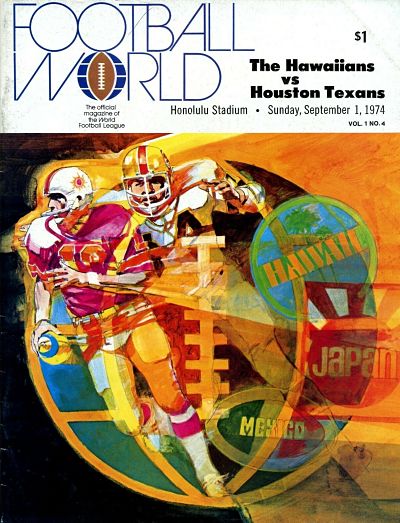 Jumpers
Jumpers
The Hawaiians made many of their biggest headlines before they ever took the field. On April 9th, 1974, the team announced futures contracts with Dallas Cowboys All-Pro running back Calvin Hill, New York Giants quarterback Randy Johnson, and San Francisco 49ers linebacker Jim Sniadecki. The team had already signed 49ers All-Pro tight end Ted Kwalick to a contract for 1975. Like many headline-grabbing WFL deals made in 1974, the contracts called for the league jumpers to play out their final option years in the NFL in 1974 before joining the WFL in 1975.
The Hawaiians also successfully poached five college draft picks from the NFL’s Los Angeles Rams franchise alone in 1974.
In Competition
The Hawaiians got off to an embarrassing start. The team was 1-7 through the first two months of the 1974 season. Rookie quarterback Norris Weese from the University of Mississippi threw 17 interceptions.
But the WFL’s marathon 20-game schedule gave Giddings’ charges time to turn things around. Two of the Hawaiians’ 1975 NFL jumpers arrived a year earlier than expected, after getting released by their NFL clubs. Randy Johnson, a first round draft pick at quarterback for the Atlanta Falcons during their expansion year of 1966, never panned out in the NFL. After the New York Giants released him in September 1974, Johnson flew to Hawaii and largely supplanted Norris Weese under center. He found a productive connection with wideout Tim Delaney, would went on to lead the WFL with 89 receptions in 1974.
FWIL FAVORITE
the Hawaiians WFL
Football Jersey
World Football League officials spoke grandly of future franchises in London, Mexico City, Osaka and Tokyo at the league’s launch in late 1973. As it turned out none of those international ambitions came to pass and Honolulu emerged as the upstart league’s most ambitious geographic flex.
This super-cool Hawaiians replica is available today from now from Royal Retros.
Former 49ers linebacker Jim Sniadecki also landed in Honolulu in September 1974 after getting traded to the St. Louis Cardinals and subsequently cut. The team also picked up long-time New York Giants cornerback Willie Williams in September. Sniadecki and Williams would combine for 10 interceptions during the second half of the season as the Hawaiians rallied from their 1-7 start to finish 9-11 and claim the WFL’s final playoff spot.
After beating the Southern California Sun on the road in the quarterfinal, the Hawaiians lost to the eventual champion Birmingham Americans in the playoff semi-final on November 27th, 1974.
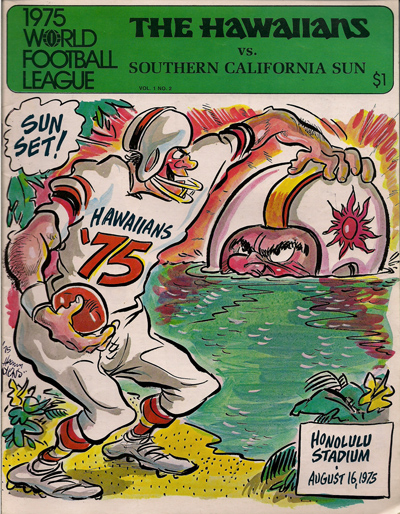 Final Season
Final Season
The original Hawaiians co-owners in 1974 were Sam Battistone, owner of the Sambo’s restaurant chain and the NBA’s New Orleans Jazz, and local resort developer Chris Hemmeter. The partnership lost an estimated $2.5 million on the Hawaiians in 19744Smith, Kit. “Hawaiians offer their prospectus … but, sports fans, there are a few risks”. The Advertiser (Honolulu, HI). February 18, 1975Both men remained in the league in 1975 but drifted away to other projects, casting the Hawaiians’ future in doubt. Battistone took over the Southern California Sun franchise. Hemmeter became President of the re-organized WFL itself and took on the daunting task of rebuilding the league’s tattered reputation after its disastrous debut.
Ultimately, a group of local owners led by local jeweler Ed Sultan stepped forward to save The Hawaiians. The team began its second season at Honolulu Stadium in August 1975. The following month, the Hawaiians left the 50-year old “Termite Palace” in favor of the $37 million Aloha Bowl. But their stay in Honolulu’s new 50,000-seat arena would last just four games.
FWIL FAVORITE
the Hawaiians WFL
Unstructured hat
World Football League officials spoke grandly of future franchises in London, Mexico City, Osaka and Tokyo at the league’s launch in late 1973. As it turned out none of those international ambitions came to pass and Honolulu emerged as the upstart league’s most ambitious geographic flex.
This cool Hawaiians hat is available today from now from Royal Retros.
The Hawaiians dealt away their rights to NFL All-Pro tight end Ted Kwalick, who joined the WFL’s Philadelphia Bell instead for the 1975 season. Former Dallas Cowboys star running back Calvin Hill did arrive as expected to be The Hawaiians marquee player. But Hill tore the medial collateral ligament in his right knee after just three games and was done for the season.
Hill’s hastily signed replacement was – of all people – Duane Thomas, Hill’s erstwhile teammate and rival in the superb Dallas Cowboys’ backfield of the early 1970’s. But Thomas was ineffective, averaging just 2.7 yards per carry. Neither Calvin Hill nor Duane Thomas ever ran for a touchdown for the Hawaiians, though Hill did score once on a pass reception.
Closure
The Hawaiians stumbled to a 4-7 record as the 1975 WFL season crossed its midway point in October 1975. But owners across the league were exhausted and, with no national television contract in hand, could see no light at the end of the tunnel. On October 22nd, 1975 the World Football League closed its doors without completing its second season.
The Hawaiians Shop
WFL Mini-Helmets
Hawaiians Mini-Helmet
This World Football League Mini Helmet is available through Royal Retros.
15 oz. mini helmet
Style worn by The Hawaiians in 1974-75
Available in the classic helmet style by Schutt
Typically ships in 3-5 business days
Fulfilled by 417 Helmets
When you make a purchase through an affiliate link like this one, Fun While It Lasted earns a commission at no additional cost to you. Thanks for your support!
In Memoriam
Quarterback Norris Weese (Hawaiians ’74) died of bone cancer on January 20, 1995 at the age of 43.
Co-owner Chris Hemmeter (Hawaiians ’74) died of liver cancer on November 27, 2003. He was 64 years old. Los Angeles Times obituary.
Quarterback Randy Johnson (Hawaiians ’74) passed on September 17, 2009 at the age of 65. Atlanta Journal Constitution coverage.
Former Hawaiians owner Edward Sultan, Jr. passed away at age 82 on October 30, 2010. Honolulu Star-Advertister obituary.
Defensive end Karl Lorch (Hawaiians ’74-’75) died on September 23, 2013.
Offensive lineman John Wilbur (Hawaiians ’74-’75) died December 9, 2013. Wilbur was 70 years old.
Downloads
10-2-1974 Hawaiians vs. Birmingham Americans Roster
10-2-1974 Hawaiians vs. Birmingham Americans Roster
10-4-1975 Hawaiians vs. Birmingham Vulcans Roster
1975 WFL Standard Player Contract
Links
###

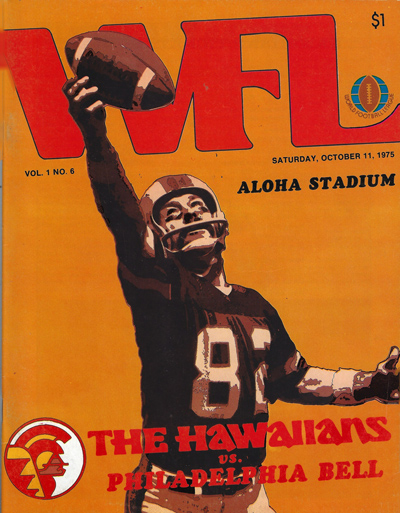

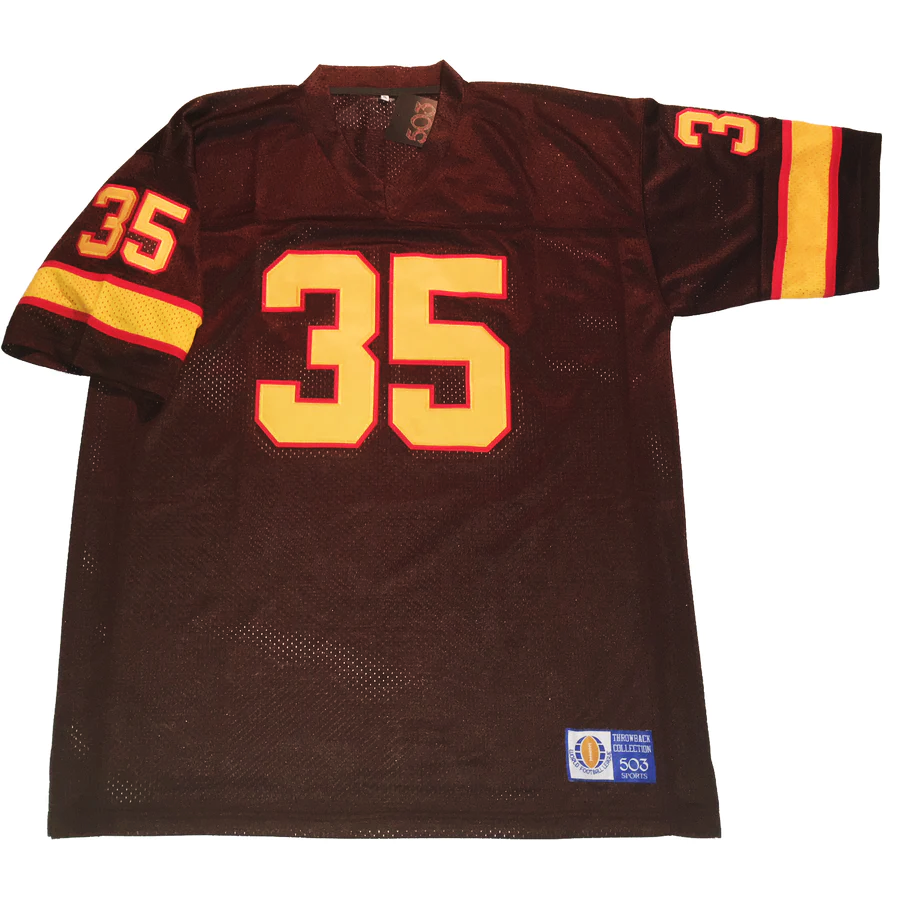

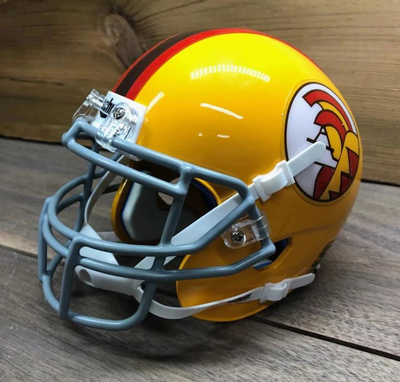
2 Responses
Quibble: while the Aloha Bowl game was played there, the stadium was actually Aloha Stadium.